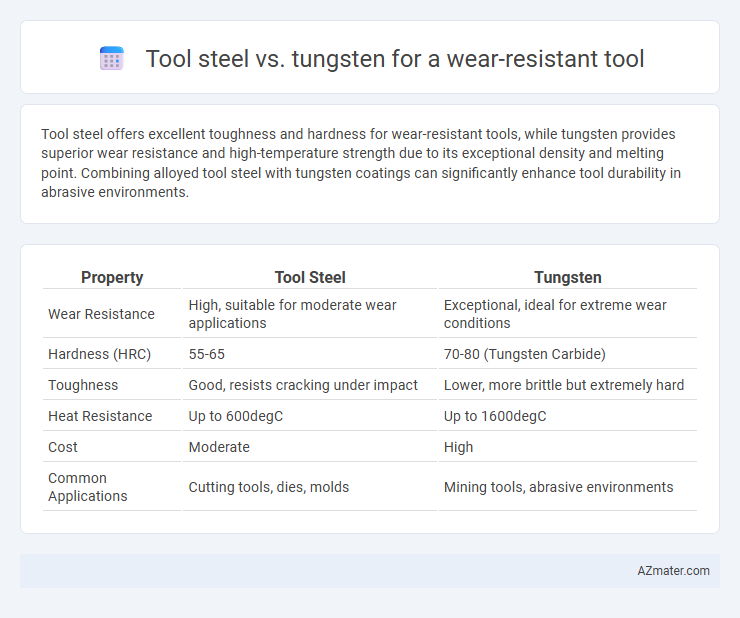Tool steel offers excellent toughness and hardness for wear-resistant tools, while tungsten provides superior wear resistance and high-temperature strength due to its exceptional density and melting point. Combining alloyed tool steel with tungsten coatings can significantly enhance tool durability in abrasive environments.
Table of Comparison
| Property | Tool Steel | Tungsten |
|---|---|---|
| Wear Resistance | High, suitable for moderate wear applications | Exceptional, ideal for extreme wear conditions |
| Hardness (HRC) | 55-65 | 70-80 (Tungsten Carbide) |
| Toughness | Good, resists cracking under impact | Lower, more brittle but extremely hard |
| Heat Resistance | Up to 600degC | Up to 1600degC |
| Cost | Moderate | High |
| Common Applications | Cutting tools, dies, molds | Mining tools, abrasive environments |
Introduction to Wear-Resistant Tool Materials
Wear-resistant tool materials such as tool steel and tungsten provide essential durability for cutting and forming applications. Tool steel offers excellent toughness and machinability, making it suitable for high-impact environments. Tungsten, with its superior hardness and high melting point, excels in extreme wear conditions, especially in abrasive and high-temperature applications.
Overview of Tool Steel in Wear Applications
Tool steel is widely utilized in wear-resistant tool applications due to its excellent hardness, toughness, and ability to retain a sharp edge under high stress. Common grades like A2, D2, and M2 offer high wear resistance through a balance of chromium content and heat treatment, making them ideal for cutting, forming, and stamping tools. Compared to tungsten, tool steel provides superior machinability and cost efficiency while maintaining dependable wear performance in abrasive and high-impact environments.
Characteristics of Tungsten as a Tool Material
Tungsten offers exceptional hardness and an extremely high melting point of 3422degC, making it ideal for wear-resistant tools exposed to high temperatures and abrasive conditions. Its superior density and tensile strength enhance tool durability, while excellent thermal conductivity helps maintain performance under prolonged heat exposure. Compared to tool steel, tungsten's resistance to deformation and wear outperforms in heavy-duty cutting, drilling, and punching applications.
Hardness Comparison: Tool Steel vs Tungsten
Tungsten exhibits significantly higher hardness compared to most tool steels, with tungsten carbide reaching up to 9 on the Mohs scale, making it exceptionally wear-resistant for cutting and drilling applications. Tool steels typically have hardness values ranging from 55 to 67 HRC (Rockwell Hardness), which, while durable, are generally lower than the hardness of tungsten carbide materials. This superior hardness of tungsten contributes to greater resistance against abrasion and deformation under high-stress working conditions.
Toughness and Durability Factors
Tool steel offers excellent toughness and moderate durability due to its balanced composition of carbon and alloying elements, making it ideal for applications requiring resistance to impact and deformation. Tungsten, with its exceptionally high hardness and wear resistance, excels in durability but tends to be more brittle, limiting its toughness under heavy shock loads. Selecting between tool steel and tungsten for wear-resistant tools depends on the specific emphasis on toughness for impact resistance or durability for abrasive environments.
Heat Resistance Performance
Tool steel exhibits high heat resistance due to its alloying elements such as chromium, vanadium, and molybdenum, maintaining hardness at temperatures up to 600degC. Tungsten, with its exceptionally high melting point of 3422degC, offers superior heat resistance and retains wear resistance under extreme thermal conditions, outperforming many tool steels. This makes tungsten the preferred choice for wear-resistant tools operating in high-temperature environments like cutting and mining applications.
Cost and Availability: Tool Steel vs Tungsten
Tool steel offers a more cost-effective solution with widespread availability for wear-resistant tools, making it suitable for large-scale manufacturing and general applications. Tungsten, while providing superior hardness and wear resistance, comes at a significantly higher price point and limited availability due to complex extraction and processing methods. The choice between tool steel and tungsten depends largely on budget constraints and the specific wear resistance requirements of the application.
Typical Applications and Use Cases
Tool steel is widely used in manufacturing cutting tools, dies, and molds due to its high hardness and abrasion resistance, making it ideal for shaping metals and forming components in automotive and aerospace industries. Tungsten, known for its exceptional density and high melting point, excels in environments requiring extreme wear resistance such as mining drills, wire drawing dies, and industrial cutting tools exposed to high temperatures and friction. Both materials serve critical roles in wear-resistant tooling, with tool steel favored for precision and toughness, while tungsten is preferred for heavy-duty applications demanding superior hardness and thermal stability.
Maintenance and Longevity Considerations
Tool steel offers easier maintenance due to its machinability and ability to be re-sharpened or tempered, extending its service life with routine care. Tungsten carbide tools provide exceptional wear resistance and longer operational longevity but require specialized equipment for sharpening and maintenance. Selecting between the two depends on balancing maintenance capabilities with the desired tool lifespan in high-wear applications.
Choosing the Optimal Material for Wear-Resistant Tools
Tool steel offers excellent hardness, toughness, and machinability, making it suitable for wear-resistant tools in applications requiring impact resistance and moderate abrasion. Tungsten, particularly in tungsten carbide form, provides superior hardness and wear resistance, ideal for high abrasion and cutting tasks but with lower toughness compared to tool steel. Choosing the optimal material depends on balancing factors like hardness, toughness, abrasion resistance, and cost-effectiveness to match specific operational demands.

Infographic: Tool steel vs Tungsten for Wear-resistant tool
 azmater.com
azmater.com